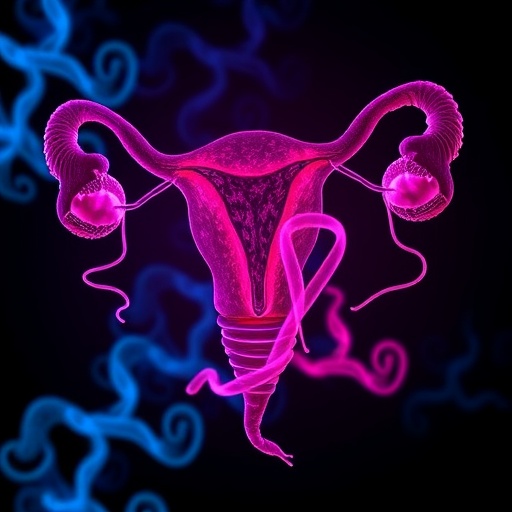Ovarian cancer continues to present a formidable challenge in the realm of gynecologic oncology, primarily due to its insidious onset and propensity for early metastatic spread within the peritoneal cavity. Despite progress in surgical techniques and chemotherapy regimens, the overall survival rates have stagnated, largely owing to the complexity of its metastatic pathways and the tumor microenvironment. Recent insights provided by an innovative study from leading Chinese research institutions have shed light on a pivotal molecular driver of ovarian cancer metastasis, revealing new avenues for potential therapeutic intervention.
Employing a sophisticated genome-wide CRISPR/Cas9 screening strategy in a clinically relevant orthotopic mouse model, scientists from Tianjin Medical University, Tianjin Central Hospital of Gynecology Obstetrics, and Nankai University have pinpointed the gene neuroblastoma suppressor of tumorigenicity 1 (NBL1) as a critical orchestrator of peritoneal dissemination in ovarian cancer. This study integrated large-scale genetic perturbations with high-throughput patient transcriptomic data, harnessing the power of forward genetics and molecular pathology to delineate the metastatic cascade.
NBL1, previously characterized in the context of neuroblastoma, exhibits a paradoxical oncogenic role in ovarian cancer by significantly enhancing metastatic potential. Quantitative PCR analyses of human primary ovarian tumors and matched peritoneal metastatic lesions elucidate a stark elevation of NBL1 expression in disseminated cancer cells. This differential expression correlates strongly with advanced FIGO clinical staging and adversely impacts both overall survival (OS) and progression-free survival (PFS), underscoring its prognostic value.
Mechanistically, the research illuminates a dual-pathway modality by which NBL1 accelerates metastatic progression. First, through direct physical interaction with key intracellular signaling proteins, NBL1 activates the Janus kinase/signal transducer and activator of transcription 3 (Jak/Stat3) axis, a critical nexus in oncogenic signaling. This activation augments cellular processes fundamental to metastasis, including proliferation, motility, and invasion, while promoting epithelial-mesenchymal transition (EMT), a phenotypic switch facilitating dissemination.
Concurrently, NBL1 exerts immunomodulatory effects within the tumor microenvironment by suppressing anti-tumor immunity. The gene’s expression is inversely correlated with the infiltration of cytotoxic T lymphocytes (CTLs), implying a mechanism whereby NBL1 fosters an immunosuppressive niche conducive to tumor survival and escape from immune surveillance. This immunological facet interlocks with the molecular signaling to potentiate metastasis and tumor progression.
Crucially, the study demonstrates the therapeutic potential of targeting this pathway through pharmacological inhibition of Stat3 using the small molecule inhibitor WP1066. In both in vitro cell lines and in vivo murine models, WP1066 treatment effectively reverses the oncogenic phenotypes driven by NBL1, reducing proliferation rates, migratory capacity, and EMT markers. These findings validate the Jak/Stat3 axis as a druggable target and position NBL1 as a biomarker for stratifying patients who might benefit from Jak/Stat3-directed therapies.
This research integrates cutting-edge genomic editing techniques with translational oncology approaches, offering a comprehensive understanding of the molecular circuitry behind ovarian cancer metastasis. The orthotopic murine model utilized reflects the physiological tumor microenvironment more accurately than conventional xenografts, thereby enhancing the clinical relevance of the findings and facilitating the translation of preclinical data to patient contexts.
Importantly, this study adds to the growing recognition of the complex interplay between cancer cell-intrinsic factors and the immune landscape of tumors. By demonstrating that NBL1 not only activates pro-metastatic signaling pathways but also modulates immune infiltration, the research underscores the necessity of combinational treatment strategies that target both tumor biology and the immune microenvironment for efficacious control of ovarian cancer spread.
From a biomarker perspective, the correlation between elevated NBL1 expression and poor patient prognosis affirms the gene’s utility in clinical diagnostics. Monitoring NBL1 levels could aid in early identification of high-risk patients and inform more aggressive or targeted therapeutic regimens, improving personalized medicine paradigms in ovarian cancer care.
While this investigation provides compelling evidence of NBL1’s oncogenic role, further studies are warranted to dissect its regulation, identify potential upstream effectors, and elucidate other interacting partners within the metastatic cascade. Understanding these molecular intricacies could reveal additional vulnerabilities within ovarian cancer cells amenable to targeted disruption.
By uncovering the NBL1-Jak/Stat3 signaling axis as a central driver of ovarian cancer metastasis and connecting it with immune modulation, this study marks a significant leap forward in cancer biology. It offers hope for the development of innovative therapeutic strategies that not only halt tumor dissemination but also invigorate anti-tumor immunity, thus improving patient outcomes in this devastating disease.
Future clinical trials assessing the efficacy of Stat3 inhibitors in NBL1-high ovarian cancer cohorts could pave the way for new standard-of-care treatments. Moreover, integrating NBL1 expression analysis into routine pathological assessments may refine prognostic accuracy and therapeutic decisions, fostering a move toward more targeted and effective patient management.
In sum, the elucidation of NBL1’s role bridges a critical gap in understanding ovarian cancer metastasis, laying the groundwork for translational applications that could transform the clinical landscape. This groundbreaking discovery exemplifies the power of CRISPR technology combined with rigorous molecular and immunological analyses to unravel cancer’s complexities.
Subject of Research: Ovarian cancer metastasis and molecular mechanisms involving NBL1 and Jak/Stat3 signaling
Article Title: A systematic CRISPR screen reveals an NBL1-mediated Jak/Stat3 crosstalk to promote ovarian cancer metastasis
Web References:
http://dx.doi.org/10.1016/j.gendis.2025.101740
References:
Qi Y, Zhang W, Li X, Shi Y, Qu P. A systematic CRISPR screen reveals an NBL1-mediated Jak/Stat3 crosstalk to promote ovarian cancer metastasis. Genes & Diseases. 2025; DOI:10.1016/j.gendis.2025.101740.
Image Credits: Yue Qi, Wenwen Zhang, Xinyu Li, Yi Shi, Pengpeng Qu
Keywords: Ovarian cancer, metastasis, NBL1, Jak/Stat3 signaling, CRISPR/Cas9, tumor microenvironment, epithelial-mesenchymal transition, immunosuppression, targeted therapy




